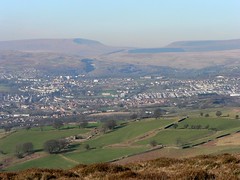
Yesterday I had my birthday trip out early, whilst all the family were still home for Easter. Because of some recent reading - Alexander Cordell's "Rape of the Fair Country" which is set in the Merthyr Ironworks of the 1830s onwards - I wanted to see for myself what Cyfarthfa Castle, the grand mansion of the Crawshays, who owned the Cyfarthfa Ironworks, really looked like. It is now owned by the County Council and has been turned into a Museum, with its wonderful grounds open to the public to enjoy. Anthony Bacon founded the Cyfarthfa Ironworks in 1765. The Castle itself was designed by Richard Lugar, and built in 1824, costing £30,000 - very extravagent in those days.

A painting of the ironworks, which was on the wall above a legitimate photography area!
According to the guide book, it covers an acre, and had its own dairy, brewhouse and icehouse. What was once a Fernery, is now a small tearoom where we had ice-creams yesterday. In the grounds were huge glasshouses where tender fruit, including exotic things like pineapples, were grown. In front of the house is a lake (which also fed water to the ironworks). On the approach to the Castle, we passed Williamstown - a row of what now look like very desirable Georgian stone 2-up, 2-down cottages, which were built to house Crawshay ironworkers.
 General view of Merthyr looking towards the mountains.
General view of Merthyr looking towards the mountains.Whilst Cordell's novel paints a very different picture of how the Merthyr ironworkers lived and were treated, William Crawshay II (1788-1867) had "a strong sense of moral duty to his workforce. He refused to cut their pay during slumps in trade and never advocated the "truck" system of company owned shops trading via tokens offered as part payment at inflated prices." The wrongful hanging of Dic Penderyn, accused of being the leader of the 1831 rising in Merthyr Tydfil, painted William Crawshay very black, and yet apparently he paid for an appeal to the Home secretary against this conviction.
Yet I think the horses in his private stables probably lived better than many of his workers, housed in filthy "under-and-over" houses, whose 2 rooms were crammed with lodgers as well as children. One of the displays in the Museum describes conditions thus: "Children barefoot and in rags, and the smell unbearable. Their hair bristled up and they were literally black with filth." What water there was, in springs and wells, stank if kept 24 hours and smelt like decayed animal matter. This was no wonder since it passed through the burial ground. There were no privies - people used fields, byways and even in the streets, where the resulting mire stank in hot weather. Queues formed for the water - 50, 80 or even 100 people long, all waiting for 6, 8 or even 10 hours just for their turn to get a bucketful of the fetid water. There was no other supply whatsoever. Even Williamstown Row, smart and bijou now, was home to terrible cholera epidemics in the mid 19th C.

It was no wonder that the Chartist movement was very strong in the area. With its beginnings in the Cotton mills of Industrial Lancashire, Chartism became a cause close to the hearts of industrial workers in the Welsh Valleys, who also sought to escape oppression. In 1839 there was a mass march of Chartist supporters on Newport, where some of their number were held captive. Zephania Williams, John Frost and William Jones led forces from their respective valleys. Jones' men failed to show, and the supporters behind Williams and Frost spent a miserable night in torrential rain waiting for them before deciding to carry on. This delay allowed troops to be brought in from elsewhere, and when they attacked the Westgate Inn, the soldiers within had an excellent stronghold and opened fire on those attacking from the hallway and fired from windows on the crowds outside. About 17 people were killed outright, and many others badly injured. The main leaders were captured and tried. Originally sentenced to death, this was commuted to transportation for life. Subsequent petitions over a number of years, some with as many as 5 million signatories, changed nothing.
Whilst there were strikes for better pay and conditions, it didn't pay to become a blackleg and work despite the strike, for the Scotch Cattle would find out and pay the blackleg a visit: The Wikipedia entry states that "The Scotch Cattle was the name taken by bands of coal miners in South Wales, analogous to the Molly Maguires in Pennsylvania, who, in disguise, would visit the homes of other local miners who were working during a strike or cooperating with employers against the local mining community in other ways and punish them by ransacking their property or attacking them physically." http://en.wikipedia.org/wiki/Scotch_Cattle


1 comment:
this is a really interesting history. There have been some great books and music written about the mines here. Emile Zola, it seems to me, was one of the authors who wrote one that impressed me greatly as a young girl. I'll have to look for the title.
There is a particular genre of music associated with our labor movement here. Did that happen with the Chartists? I'll look for some lyrics or even A/V links if I can find them...If you're interested let me know. I'm enjoying pondering the parallels in our respective histories.
Nancy
Post a Comment